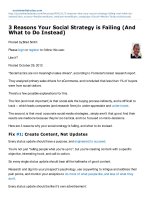Why customer service is failing and why its time to turn it upside down
Bạn đang xem bản rút gọn của tài liệu. Xem và tải ngay bản đầy đủ của tài liệu tại đây (34.12 MB, 30 trang )
Why customer service
is failing and why it’s time
to turn it upside-down.
There’s no nice way to say this:
Customer service, on average,
ranges from disappointing to
The ‘good’ news is that expectations
are really, really low.
When an issue comes up, we all expect
to be thwarted, delayed, frustrated and
ignored on our twisted route to resolution.
The bad news is that expectations
are rising fast.
Some innovators have seized market
share quite visibly on the back of fantastic
customer experiences and stellar service
and support.
We’re all starting to expect more.
Chances are, you’re being
outplayed right about now
by one of these disruptors.
Which means you’re going to lose out
to companies that don’t just ‘get’ great
customer service but live it with every
fibre of their corporate body – and
deliver it with outrageous consistency.
Here’s the crux of the problem:
In most businesses, the customer
service agent works for the company.
In great customer companies,
the company works for the customer
service agent.
And this ‘upside down’ approach
changes everything.
Some are in consumer markets,
some in B2B.
Some sell shoes, others books,
or flights or data centers.
But they all have one thing in common:
They all empower their customer
service agents.
It’s all about the people.
Great customer companies recognise
that their entire service culture and
every penny invested in customer delight
comes to life (or dies a slow death) in
the hands of the people who touch
customers every day.
So they treat them like the most
important people in the company.
Which is exactly what they are.
Yes, the new customer service heroes
have fantastic service cultures that start
from the very top.
There’s never any doubt in any corner of
the business what the top priority is and
how people should behave every day.
And yes, they hire better, train harder
and monitor more closely.
They only employ people with enormous
empathy, pour their service culture into
every one – and weed out the people
who don’t get it.
But then they do something else:
they really give their customer service
people the power to do their jobs.
Instead of tying their hands with rules,
policies and productivity metrics, they
free them to do what their hearts tell
them; inspire them to do great things;
and reward them when they do.
How do they empower their agents?
We talk about this in a recent blog post,
but it’s worth hitting the key points here.
Customer agents are empowered
and encouraged to delight customers.
Because they can't deliver great service
with handcuffs on.
The knowledge of the entire company
is at their fingertips.
Because clueless support agents can’t
help anyone.
To help them find and enlist the
very best people in the company
(often with some kind of social
collaboration tool).
Because no one is too important
to help a customer.
So they can see a rich profile of
each customer and their entire
interaction history before they
even open their mouths.
Because there’s no excuse
for ignorance any more.
By using self-service channels for the
easy, routine stuff, agents have more
time to dig into the trickier cases.
Because customer service agents
are far too important to waste.
Great customer companies tend
to have great customer communities
that weigh in and help each other out.
Because happy customers are the
best and smartest advocates.
That’s what an upside down service
operation looks like.
Led by empowered agents with the
backing of the entire organisation and
armed with the knowledge, tools and
inspiration to create impossibly great
customer experiences.









